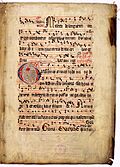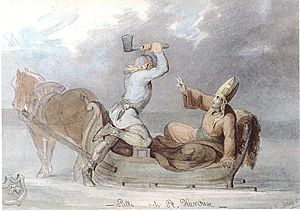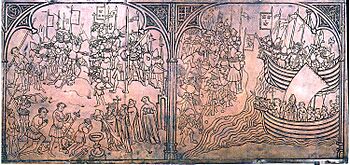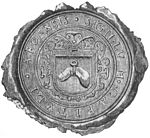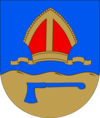Henry (bishop of Finland) facts for kids
Quick facts for kids Henry |
|
|---|---|

Painting from the Church of Taivassalo about 1450.
|
|
| Bishop, missionary, martyr | |
| Born | c. 1100 Kingdom of England |
| Died | Traditionally 20 January 1156 Lake Köyliö, Finnic tribal lands (now Finland) |
| Venerated in | Catholic Church Anglican Communion Lutheranism |
| Canonized | Pre-congregation |
| Major shrine | Earlier Cathedral of Turku, today only Catholic Cathedral of Helsinki |
| Feast | 19 January |
| Patronage | Catholic Cathedral of Helsinki |
| Controversy | Existence disputed |
Henry (Finnish: Henrik; Swedish: Henrik; Latin: Henricus; died around January 20, 1156) was a religious leader from England in the Middle Ages. He is believed to have traveled to Sweden in 1153 with a special church official named Nicholas Breakspeare. Henry was probably meant to become the new Archbishop of Uppsala, a very important church position.
According to old stories, Henry went to Finland during the First Swedish Crusade, a kind of religious military trip, with King Eric the Saint of Sweden. The stories say he died as a martyr, meaning he was killed for his beliefs. Because of this, he became the patron saint of the Catholic Church in Finland. However, many historians question if these stories are true. There are no clear historical records of his birth, death, or even if he really existed.
Despite these questions, Henry and Lalli, the peasant who supposedly killed him, are important figures in the early history of Finland. Many churches, including the main Lutheran church in Finland and the Catholic Church, celebrate his feast day. He is also remembered in the calendars of some Lutheran and Anglican churches.
Contents
The Legend of Saint Henry
His Life and Miracles
The main story about Bishop Henry's life, called his Vita, was written about 150 years after he supposedly lived, in the late 1200s. It doesn't give many clear details about him. It says he was an English bishop in Uppsala, Sweden, during the time of King Eric the Saint in the mid-1100s. They supposedly ruled peacefully together.
To deal with non-Christian Finns, King Eric and Henry reportedly went to battle. After winning, baptizing people, and building churches, the king went back to Sweden. Henry stayed in Finland, preferring to be a preacher rather than a high bishop.
The legend ends when Henry tried to punish a murderer according to church rules. The angry man then killed the bishop, making Henry a martyr. The story strongly says Henry was a Bishop of Uppsala, not a Bishop of Finland. It doesn't say if there were bishops in Finland before him or what happened after his death.
The Vita is followed by a list of eleven miracles, called miracula, that supposedly happened after Henry's death. Most of these miracles took place in Finland after people prayed to Bishop Henry. Some examples include:
- A boy was brought back to life.
- A blind woman could see again.
- A man with a paralyzed leg could walk.
- Fishermen survived a storm.
How the Legend Grew
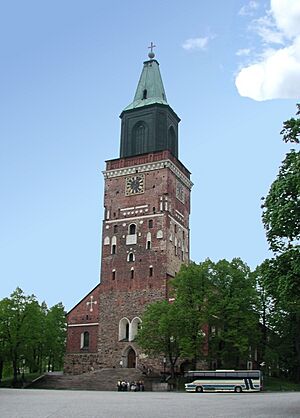
The story of Henry and his trip to Finland was also part of King Eric's legend. Henry and the crusade first appear in a version of Eric's legend from 1344. Henry's own legend was likely written in the 1280s or 1290s. This was probably for the opening of the Cathedral of Turku in 1300. At that time, his supposed remains were moved there from Nousiainen, a town near Turku.
When Henry First Appears in Records
The first time Bishop Henry is mentioned in historical writings is in 1298. He is named with King Eric in a document from a church meeting in Uppsala. The legend itself is also first mentioned in a letter from the Archbishop of Uppsala in 1298. This letter talks about Eric and Henry as martyrs. It asks people to pray to them because of the situation in Karelia. This connected their supposed crusade to Finland with new military trips against Novgorod. The war between Novgorod and Sweden for control of Karelia had started in 1293.
Henry's image first appeared on the seal of the Bishop of Turku in 1299. He was first called a patron saint of Turku cathedral in 1320. By 1391, Pope Boniface IX called him a saint and a patron of the Turku Cathedral, along with the Virgin Mary. Some stories claim Henry became a saint in 1158, but this is generally thought to be made up.
This shows that Henry's worship as a saint and his connection to King Eric seemed to appear in historical records around the same time in the mid-1290s. This was strongly supported by the church.
How Henry Was Honored

Even though Henry's worship started in a big way, it took over 100 years for people across Sweden to widely accept him as a saint. In the 1300s, people outside the Turku area rarely honored Henry. A place called Vadstena Abbey helped spread Henry's legend in other parts of Sweden in the early 1400s.
By the end of the Catholic era in Sweden, Henry was a well-known local saint. He was honored in many church areas in Sweden and nearby countries.
In the Turku area, Henry's yearly feast day was January 20. This was traditionally the day he died. Elsewhere, his day was January 19 because other important saints were honored on January 20. After the Protestant Reformation, Henry's day in Finland also moved to the 19th. His feast day is first mentioned in 1335. Another day of remembrance was June 18. This was the day his relics (bones or other items) were moved to the Cathedral of Turku.
A special song for Henry, called Gaudeamus omnes ("Let all rejoice"), has survived from the late 1300s or early 1400s.
Political Reasons for the Legend

The legend says that the church in Finland was started entirely by the saint-king Eric of Sweden, with help from the bishop. The story describes the king and bishop ruling Sweden like "two great lights" in peace. This was a happy time when "predatory wolves" could not harm the "innocent."
However, real life was quite different. King Eric's time was very violent for Swedish royalty. The legend describes the crusade as a quick and peaceful event. It says it was only done to bring the "blind and evil heathen people of Finland" into Christianity.
The person who wrote the legend seemed to want to show the bishop as a humble martyr. They did not focus on where he died or was buried. These details were more important in local Finnish folk stories. Over time, the church's legend and the folk stories influenced each other. The church slowly added more details from the folk traditions to its saint's story.
Folk Stories About Henry
One of the most famous folk stories about Henry is a poem called "The Death-lay of Bishop Henry." This poem mostly ignores Henry's life and focuses on how he died.
Henry's Background in Folk Tales
The poem says Henry grew up in "Cabbage Land." This has puzzled historians for a long time. It might refer to a coastal area in Finland called Kaland.
Folk stories do not mention the crusade at all. King Eric is only briefly mentioned as Henry's "brother." In these stories, Henry appears as a lone preacher who traveled around southwestern Finland by himself. He has little in common with the Henry in the church's official story.
Kokemäki is often mentioned in these stories as a place where Henry preached.
Henry's Death and Burial
The poem's version of Henry's death is different from the church's story. The bishop's killer was named Lalli. Lalli's wife, Kerttu, falsely told him that Henry had taken food, cake, and beer without permission. She also said he took hay for his horse and left nothing. This made Lalli so angry that he chased Henry on skis. He caught Henry on the ice of Lake Köyliönjärvi and killed him.
Lalli then took Henry's hat, called a mitre, and put it on his own head. Lalli then died a painful death. The poem describes Henry going to heaven and Lalli suffering in hell.
Medieval folk stories list the bad things that happened to Lalli after he killed the bishop.
How Folk Stories Developed
The death-lay is a simple story about a short-tempered man who is tricked by his "bad-mouthed wife." The poem does not feel sorry for Lalli. It shows Kerttu as the real problem. This story about Henry's death came from a separate tradition. This tradition was once very different from the church's legend, which is mostly forgotten today. We don't know if both traditions are about the same person.
The poem, which uses a traditional Finnish style, has survived in several written versions from the 1600s and 1700s. Some parts of it appear in older works, but it is probably not much older than the church's story.
The names Lalli and Kerttu are originally German. This might mean the poem was partly based on foreign stories. For example, how Lalli is tricked and what happens to him later seems to come from a medieval story about Judas Iscariot.
Based on old church ruins on Kirkkokari island in Lake Köyliönjärvi, people started honoring the bishop there in the late 1300s. This was long after Henry became an official local saint. A small building in nearby Kokemäki, said to be where the bishop rested before he died, was built no earlier than the late 1400s.
However, the poem's claim that Henry was buried in Nousiainen was believed to be true around 1300. This was when his supposed bones were moved from Nousiainen to the Cathedral of Turku. The church seems to have slowly added parts from the folk stories to its own legends, especially in the 1400s.
Historical Questions About Henry
Today, some historians question the legend of Henry. They even call it pure imagination. It was not unusual for saints to be completely made up in Europe. There is no direct proof of the crusade or Henry himself.
However, the bishop's supposed violent death does not mean he did not exist. Many bishops were killed during the troubled times of the 1100s and 1200s.
Bishop of Uppsala?
There are no historical records of a Bishop of Uppsala named Henry during the time of King Eric (around 1156–1160). The early history of this church area is unclear until Stefan became archbishop in 1164.
A later story from the 1400s claimed that Henry came to Sweden with a church official named Nicholas Breakspear (who later became Pope Adrian IV). It said Nicholas appointed Henry as the Bishop of Uppsala. While Nicholas was in Sweden in 1153, there is no record of anyone named Henry with him. Also, there is no mention of him appointing a new bishop in Uppsala.
Another story from the 1100s mentions a Bishop Henry of Uppsala in 1129. He died in a battle in 1134. This Henry was banished from Sweden and fled to Denmark. It is possible that the story about a killed bishop in Uppsala in the 1100s was later used in the new legend about Henry in Finland.
Also, a writer named Adam of Bremen wrote in 1075 about a foreigner named Hericus. He was killed while preaching among the Swedes. Some historians think this story is too similar to the later legend of Henry to be a coincidence.
Bishop of Finland?
No historical record confirms a bishop named Henry in Finland. However, letters from the Pope mention an unnamed Bishop of Finland in 1209, 1221, 1229, and 1232. The first bishop of Finland we know for sure is Thomas, first mentioned in 1234.
A papal letter from 1171 (or 1172) by Pope Alexander III does not mention a Bishop or Diocese of Finland. The Pope knew about the church in Finland and mentioned that preachers from Sweden were working there. He was worried about Finns treating them badly.
No list of bishops or church areas under the Archbishop of Uppsala from 1164 to 1248 mentions Finland. No claim about a Swedish bishop in Finland is made in any other source before the so-called Second Swedish Crusade in 1249.
The first mention of a bishop in Finland is from a papal letter in 1209. It was sent to Archbishop Anders of Lund. The Archbishop said the Bishop of the new church in Finland had died. He complained how hard it was to find someone to be a bishop in Finland. The Pope approved his suggestion to appoint someone who was already working there.
It is important to note that the church in Finland was called "newly established" in 1221, just as it was in 1209. This suggests that the early bishops of Finland might have been appointed by the Danes, not the Swedes. Old Finnish tax systems also have roots in Denmark. This suggests Finland was a Danish mission area at that time.
Henry's Lasting Impact
His Relics
Henry was supposedly buried in Nousiainen. His bones, or what people thought were his bones, were moved to Turku in 1300. The church in Nousiainen was later decorated with a large stone tomb in the 1400s. A copy of this tomb can be seen in the National Museum of Finland in Helsinki.
Most of the bones in Turku were still there in 1720. They were listed to be moved to Saint Petersburg during a Russian occupation. What happened to them after that is unknown. Some say the ship carrying them sank. However, a piece of Henry's arm bone was kept in a special container in the Turku Cathedral. This piece is now in the St. Henry's Cathedral in Helsinki.
In 1924, a skull and other bones were found in a sealed closet in the Turku Cathedral. These are sometimes called Henry's relics, but this is not certain. They are stored in the Turku Cathedral today.
Henry's Status Today

Even though Henry has never been officially made a saint by the church, he has been called a saint since 1296. He is still called a saint today. Henry is remembered on January 19 in the calendars of some Lutheran churches. January 19 is also Henry's name day in Sweden and Finland. He is still honored in the Catholic Church of Finland, whose only cathedral is named after him.
The Kirkkokari island in Lake Köyliönjärvi is the only Catholic pilgrimage site in Finland. A memorial service is held there every year. Also, a medieval walking route, the Saint Henry's Way, from Köyliö to Nousiainen, has been marked for people who want to walk it.
Based on folk stories about the bishop, the towns of Nousiainen, Köyliö, and Kokemäki use images from Henry's legend in their official symbols.
Today, Henry and his supposed killer Lalli are two of the most well-known people from Finland's medieval history.
See also
- Saint Henry, Bishop of Finland, patron saint archive


